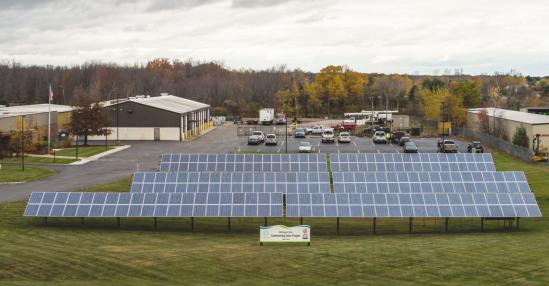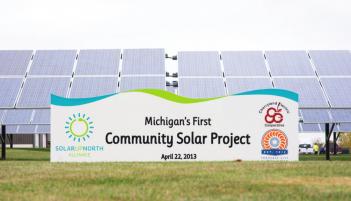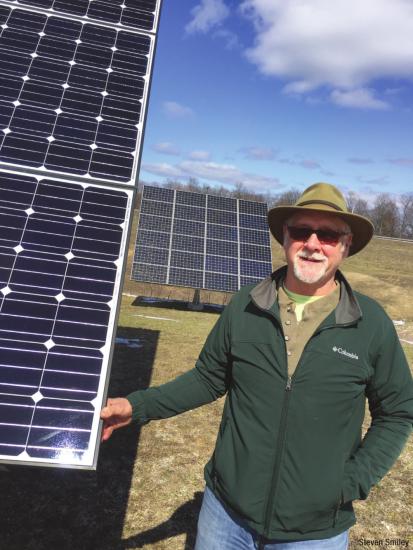The Green One Percent
Early Adopters of Solar Technology Worry About a Utility Backlash
April 15, 2016

Electric utilities are pushing back against incentives encouraging people to go solar and conserve energy. The latest local example of this nationwide struggle flared up in March, when Cherryland Electric Cooperative’s board of directors approved a measure to slash what it pays for solar panel-generated kilowatts beginning in November.
Cherryland says the move is an effort to ensure solar panel owners are not subsidized and don’t save money on the backs of traditional customers. Solar advocates say the policy will double the time it takes to pay off a solar system and will grind installations for Cherryland customers to a halt.
"A DIRTY TRICK"
Steve Smiley, part of a nonprofit working to make electric power for the tip of Leelanau County 100 percent renewable, said Cherryland’s move to cut credits that solar owners receive for electricity they return back to the grid from 11 cents per kWh to 3.5 cents is "a dirty trick."
"They want to keep buying the coal and they want to come up with complicated, crazy scenarios to make solar less viable," Smiley said. "The problem is we’re in a race against time and the co-op’s just kicked the can five years down the road."
Smiley is motivated by his concern for what traditional power generation does to the climate.
Cherryland spokeswoman Rachel Johnson said her utility is not trying to stop solar projects and they are committed to developing renewable energy. Existing residential solar owners, and those who are set up by November, will be grandfathered and their rates will not change under the new policy.
Johnson points to the Solar Up North Alliance, a community solar project launched with Traverse City Light & Power (TCLP), which allows customers to buy into solar energy so that part of their bill comes from renewables. That project is completely subscribed and Johnson said the cooperative plans to expand.
A SOLAR FUTURE

Solar advocates say community solar projects are not enough. They want to see solar spread across the grid. They want to see the grid transformed into a decentralized system where neighbors share electricity with neighbors, lessening the need for many big power plants. They see a future of battery packs storing energy and houses fueling electric cars.
To that idea, the utility industry says, "Not so fast."
Even if a lot of customers remove themselves from the grid, many of those customers will still want to be connected to the grid, if only for emergencies when the sun doesn’t shine and the wind doesn’t blow. Those people, the industry says, should have to pay for that connection. Johnson said Cherryland’s rate change is designed to ensure solar adopters pay for the grid like everybody else.
"All this is doing is it’s designed to take the subsidy out of the rate," Johnson said.
She noted that some utilities take a more extreme posture on solar in what’s called a "buy all, sell all" model: Solar owners sell all of the electricity they generate to the utility at a wholesale rate and then purchase the electricity they use at the retail rate.
Dan Worth, a clean energy policy specialist at Groundworks Center in Traverse City, said Groundworks wants to get utilities and solar advocates to work together to increase the spread of solar.
"We are hoping to use the coming year to prove to both TCLP and Cherryland that there is demand for solar, and an appetite to share some of the cost, in their territories," Worth said.
THE LESS THAN ONE PERCENT

Cherryland’s current solar customer base – similar to numbers across the country – is miniscule. It is a fraction of one percent.
The Michigan Public Service Commission estimated the rate of customers who participate in net metering programs in Michigan was .015 percent in 2014. That’s a small number, but it was a 25 percent increase from 2013.
Forty or 50 Cherryland customers own solar panels; they were issued $10,500 worth of credits in 2015. That’s enough electricity to power 16 average households. It’s also a pittance for a cooperative that saw revenues of $52 million and serves 33,000 customers.
Nonetheless, Johnson said $10,500 in credits is a lot, if you consider it’s divided between so few customers. That’s an average of $233 in savings for each solar panel customer. Johnson said the utility determined Cherryland’s bottom line would crash if the number of solar customers exploded.
She said Cherryland looks at that $233 credit to each solar customer as coming out of the pockets of all the customers who don’t have solar.
"What you’re really talking about is the other members paying that, just so 40 people" can get net metering credits, Johnson said. "It was just not going to be sustainable as the program grew."
The $10,500 isn’t a net loss for Cherryland, however, said Tom Gallery, owner of Leelanau Solar, an installer of solar systems. For one, no one ever gets paid money for excess energy they produce; they get a credit they can use to buy energy in the future.
Also, the $10,500 represents the money spent for that amount of electricity at a retail rate, which is 11 cents per kWh, so Cherryland is able to sell that electricity for what it pays for it.
"They keep saying, "˜Oh, this costs us.
We’re paying for this.’ Well, they’re not paying for anything," Gallery said.
Gallery said the rate change will alter the economics of solar projects enough to make them completely unattractive to Cherryland customers.
A DEBATE OVER THE BEST GRID
At the core of this dispute is whether a centralized system of electricity delivery makes sense or whether it would be better for society to have a decentralized system that involves lots of solar arrays at people’s homes, wind turbines here and there and perhaps other innovations people haven’t even thought of yet.
Brian Wheeler, spokesman for Consumers Energy, said it’s better if solar and wind projects are bundled together on large scales. That makes them cheaper to build and more efficient to operate. Also, they enable customers to buy in without having to invest in actually installing and maintaining their own system.
"Maybe you don’t have good sun on your property; maybe you live in an apartment," Wheeler said.
Consumers Energy, as a regulated corporation, is required by state law to pay solar customers retail credits for excess electricity they generate. That law does not apply to cooperatives or municipal systems like Cherryland or TCLP.
Wheeler said net metering makes solar customers tiny power generators, but they aren’t like other power generators because they don’t have infrastructure costs.
"The reality is that, usually when you’re producing electricity, you get paid at a wholesale rate," Wheeler said.
He said Consumers supports changing state law so that future solar customers across the state would receive the wholesale rate, instead of the retail rate. There was a Senate bill introduced last fall that would have done that, but it failed.
Wheeler said the rate paid to solar producers could take into account other benefits of solar, like the fact that it is clean energy. He said that should be decided by the legislature.
"Our guiding principal is fairness," Wheeler said. "If you have solar panels on your home and turbines, and you’re generating electricity, you receive a credit that is consistent with what any other power generators would receive."
ELECRICAL EVAPORATION
When electricity travels distances, some of it is lost in heat as it moves along power lines. That gives residential solar arrays an advantage; it’s just one factor Cherryland’s policy doesn’t take into account, said Skip Pruss, principal and co-founder of 5 Lakes Energy. Utilities were not prepared for the seismic shift posed by renewable energy and conservation, he said.
"Now we’re moving into a different paradigm, where customers are no longer just customers, but are becoming part of the power system," Pruss said. "You would think that would necessarily give us a voice."
He said, utilities like Cherryland should strive to be more transparent and involve more input from their customers; they should be undertaking a public process to better understand what the costs and benefits of solar energy are within their power system.
Pruss is certain the value of solar to Cherryland far exceeds the 3.5-cent wholesale cost they claim and even the 11-cent retail cost they’ve been paying in credits. Pruss said studies have shown that solar can be worth three times that retail figure because it is generated during periods of peak demand, it is used by neighbors and doesn’t require long transmission, and it forestalls a utility’s need to invest in new power plants, as coal plants age out. There are also environmental and health benefits that come from clean energy.
The real reason utilities like Cherryland are moving to restrict solar is because of the threat it poses to the way they’ve done business for decades, he said. The Edison Electric Institute, a utility trade group, spelled it out in a January 2013 paper about "disruptive challenges" to the power industry. Solar has the potential to knock traditional utilities into a death spiral, the report concluded.
An even more pressing threat to utilities is energy efficiency, Pruss said. Savings from LCD bulbs, for example, immediately threaten to displace 300 times as much traditionally-generated electricity as solar.
"You would think the response would be to come up with other business models," Pruss said.
FLAT FEES RISING
There are other ways utilities can survive in an environment where customers cut their electricity use, whether through solar or conservation. Cherryland and other utilities are trying to accomplish this by raising flat fees so that people pay more for the cost of access as they use less power.
The flat-rate fee for Cherryland customers is slated to double over one decade. It was $12/month in 2007, $13 in 2009, $15 in 2011 and the co-op hopes to increase it to $24, Johnson said.
Johnson said the utility determined the fee should be $24 to achieve what they refer to as "cost-based rate making." That means they attempt to ensure customers pays their fair share, she said.
Gallery said, if a utility increases its flat rate while the cost per kWh stays the same, that creates a subsidy that punishes people who conserve energy. People who use less electricity pay more per unit; people who use more pay less.
"There’s no question about that; it’s pretty easy to do the math," Gallery said.
Johnson said the fees have not been increased to punish people who conserve.
"It would never be done to penalize people," she said. "Regardless of whether you use a kilowatt, this is the cost to make that accessible to you when you use it. It’s not designed to be punitive."
CLOSED MEETINGS
Solar advocates were frustrated by the lack of transparency in the process Cherryland used to enact its new net metering policy. There was no public hearing; it was discussed and approved in board meetings that are not open to the public.
Smiley said Cherryland’s decision-making completely lacks transparency.
"They just do whatever they want to do and then get the board to rubber-stamp it," Smiley said.
He said the Northport Energy Action Task Force is planning to call for Cherryland to hold a public hearing on net metering. Johnson said Cherryland’s board of directors meetings are not open to the public because they are a nonprofit and they are not required to hold open meetings.
"We are not a public utility like Traverse City Light & Power," Johnson said. "We’re not required to make our meetings public."
Johnson said the net metering changes were discussed on Cherryland’s website and in podcasts; she said anyone who wants to question Cherryland policy can contact General Manager Tony Anderson. She said the net metering changes were discussed in members’ advisory committee meetings, which are open to members and which Smiley and Gallery attended. Smiley said he doesn’t recall a meeting where the details of the net metering policy change were discussed.
"Change is hard and the utilities are struggling and the national lobbying units are putting forward things to say solar net metering is bad," said Bill Queen, a solar instructor at Northwestern Michigan College.
"The utilities have a certain business model which they've been used to for decades. It’s just tough for them to envision a more forward-thinking type of policy and actually embrace it."
Trending

The Valleys and Hills of Doon Brae
Whether you’re a single-digit handicap or a duffer who doesn’t know a mashie from a niblick, there’s a n... Read More >>
The Garden Theater’s Green Energy Roof
In 2018, Garden Theater owners Rick and Jennie Schmitt and Blake and Marci Brooks looked into installing solar panels on t... Read More >>
Earth Day Up North
Happy Earth Day! If you want to celebrate our favorite planet, here are a few activities happening around the North. On Ap... Read More >>


